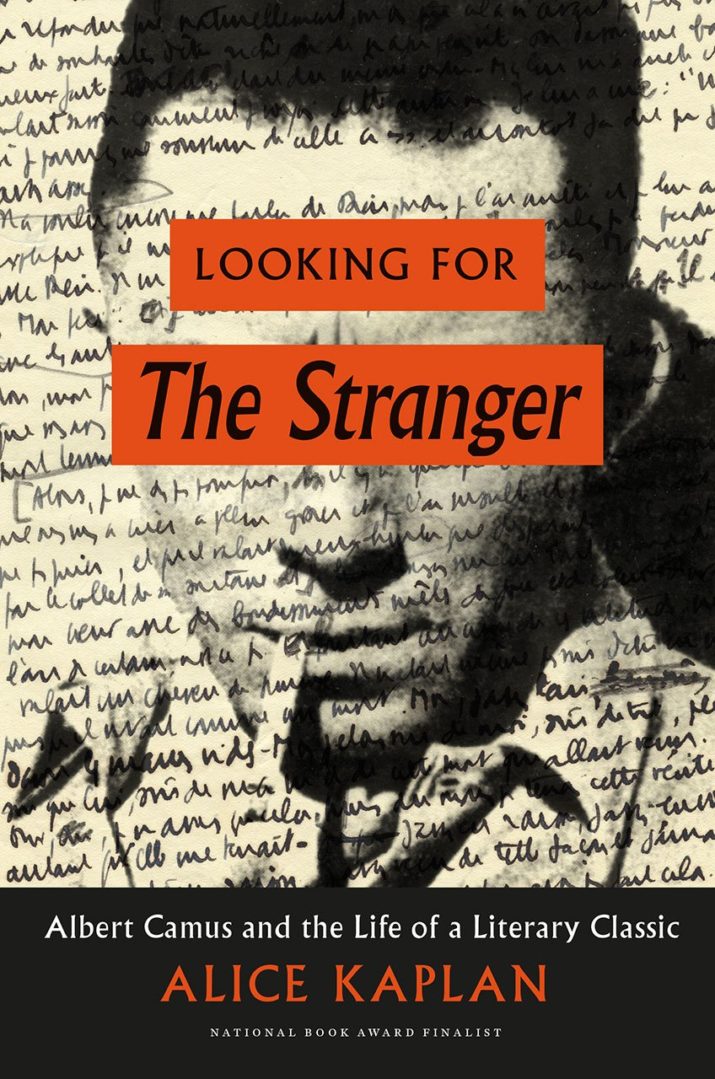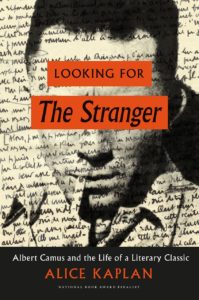
 It would not take long for a group well-schooled in the silence of the universe, to reach the speculation that The Stranger was a contingent event, a happen-so that could easily have not happened: it is not hard to imagine a manuscript being lost in the chaos of parcels mailed during World War II; nor difficult to imagine German censors seeing no merit in a book where a priest is reviled; nor difficult to imagine that for a young man with tuberculosis, the damp of Europe might have proven too much for his weak lungs.
It would not take long for a group well-schooled in the silence of the universe, to reach the speculation that The Stranger was a contingent event, a happen-so that could easily have not happened: it is not hard to imagine a manuscript being lost in the chaos of parcels mailed during World War II; nor difficult to imagine German censors seeing no merit in a book where a priest is reviled; nor difficult to imagine that for a young man with tuberculosis, the damp of Europe might have proven too much for his weak lungs.
But Kaplan has rescued us from the possibility of there never being a Camus scholar who would pull together the threads of this story, the story of the coming to be of The Stranger. And so the silent universe has been twice bested, bested first by Camus, for seeing The Stranger into print and well-launched into the world, and bested by Kaplan, for giving us the journey of The Stranger, from Camus’ scribbles to cultural touchstone.
Kaplan chooses a linear approach to her task, giving the reader a chronological narrative, from Camus as clerk, writing The Stranger, to the current life of Camus’ first novel as it inspires Kamel Daoud’s lauded 2013 The Meursault Investigation. Chapter by chapter, we are shown the contingency of the journey, even as we readers artificially make the continent into the necessary, by our knowing today the importance of The Stranger.
Kaplan’s text is sprinkled with gems, a-ha moments, as Camus’ inspirations for Meursault and The Stranger are collected by her. She notes that Saint Augustine, a key philosopher in Camus’ master’s thesis, “refused to weep at [his mother’s funeral] and looks for a cure for his sorrow by going to the baths” (11). Camus’ first working title for the novel was The Indifferent Man. Attending the funeral of his brother’s mother in law in May of 1937, Camus notes “a little old man, the fiancé of the old woman who has died” (31). In 1938, as a court room reporter, Camus sees an Arab witness harassed by a Christian French magistrate, who waves a crucifix at Akacha, the Arab witness. Camus captured Akacha’s reply, that “No, I don’t believe in God. He is too old. He needs to be changed.” This scene too will find its way into Meursault’s journey.
Kaplan spends time on how James M. Cain’s The Postman Always Rings Twice gives Camus the strategy of having Meursault narrate his story in the first person from his prison cell. And how Cain’s narrator refers again and again to “the Greek,” unnamed; Meursault’s “the Arab” has his anonymity born. Camus watches a Fernandel film. Camus’ friends Rauol and Edgar Bensoussan fight with a few Arabs, on a beach usually reserved for Europeans. Overall, as with Elizabeth Hardwick’s “Camus: A Romance,” the reader is treated to treasure after treasure, rescued from the past, details small and great, that one can attach to the Camus story. With these experiences recorded in his notebooks, by 1940, Camus is in Paris, alone in a hotel room, the room where the writing of The Stranger is achieved.
Having shown us the experiences that are being distilled in the novel, Kaplan next shows us the forces that will decide the fate of that novel – Camus’ friendship with Pascal Pia, first and foremost. Pia will press Camus’ manuscript upon first Andre Malraux, and then the great French publisher, Gaston Gallimard. Despite initial negative comments by Camus’ mentor Jean Grenier, the overall prepublication reception of Camus’ text is one of extreme praise. While Camus is back in Algeria, Gallimard successfully navigates the politics of publishing under the eyes of German censors. And Camus’ novel, even when reviewed harshly, is always loudly reviewed, and immediately takes its place within the story of French literature.
This is where most success stories would end. “I wrote a great novel. It was published. It was read with appreciation and respect. I had my day in the sun.” But for Camus, a series of additional boosts occur, propelling The Stranger into a perennial title. Sartre champions Camus, both in France and in America. The publisher Knopf speedily translates The Stranger into English, in large part to establish a relationship to purchase Camus’ second novel, The Plague. Camus himself explodes as a voice in France, with his writings for Combat giving him ongoing respect and visibility. As Kramer sums it up, “What was remarkable was that only a year and a half after the publication of his first novel, Camus’ book was already an obligatory reference” in the story of French Literature (161).
And then another twist. As Kaplan tells it, in America “Teachers realized that Camus’ first novel was perfectly suited to teaching French, a perfect bridge from language study to literature” (193). And so generations would read The Stranger, in French or English, as part of the curriculum.
We know much of the rest. Camus, recipient of the Nobel Prize in Literature, dead at 46, from a car crash, his wife Francine who “couldn’t help but think of the wake at Marengo in The Stranger” (199) as she sees Albert’s body on view.
Kaplan ends by adding her own stone to the temple in her Epilogue, as she sleuths, seeking out the actual events that inspired Camus’ story of the Arab killed on the beach. First, she interviews Kamel Daoud, author of “The Meursault Investigation,” his novel a homage to The Stranger, and published in 2013, the year of Camus’ centennial. Then, while still in Algeria, she investigates the story of the Bensoussan brothers and their fight on a beach with some Arabs. The Arab is finally given a name, “Kaddour Touil, aged 19 at the time of the fight,” thanks to Kaplan’s research in a newspaper clippings archive. In 2014, Kaddour is now dead, but Kaplan finds and interviews his brother and sister. Filling in the story of “the Arab,” Kaplan then muses upon the parallels between the lives of Camus and Touil. Both men had tuberculosis, both were handsome and full of life, both journeyed to France seeking treatment for tuberculosis. Kaplan ends her work thus: “The two [Camus and Touil] didn’t cross paths in a hospital ward in France; they were separated by the Rhone river and their dates don’t quite align. But they might have. My search for The Stranger ends with this fantasy of reconciliation – Kaddour Touil and Albert Camus in their respective mountain clinics, healing” (217).
In sum, this book is a history. A history loving told. A history that will be valued by Camus’ many grateful readers.
Reviewed by Dr. David Stegall, Clemson University
Looking for The Stranger: Albert Camus and the Life of a Literary Classic
by Alice Kaplan
Publisher: The University of Chicago Press
Paperback / 288 pages / 2016
ISBN: 9780226241678
Published on July 20, 2017.




